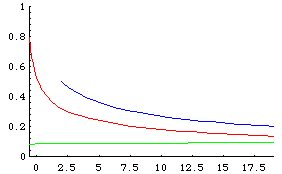
The lowest order renormalization group equations for the force strengths and Yukawa couplings in the F4 model can be studied by using Mathematica NDSolve:

The variables c (and cc), w, and e (and ee) are the color, weak, and electromagnetic charges, using the unconventional convention that a = g^2 rather than
a = g^2/4¹ for charge g.
The conventional renormalization equation is of the form
MdC/dM = - 7C^3/16¹^2, with C^2/4¹ = ac, so that C = (Ãac)(2ù).
If c^2 = ac, then C = c 2ù so that Md(2ùc)/dM = - 7 x 8¹Ã¹c^3/16¹^2, so the lowest order renormalization equations are then:
Mdc/dM = -7c^3/4¹ ; Mdw/dM = -3.3w^3/4¹; and Mde/dM = +4e^3/4¹ .
Since Md /dM = d /dlnM = d / 2.3logM , there is a conversion factor for plotting c, w, and e against logM.
The U(1) electromagnetic charge e takes the values 0.085 at 0.1 GeV, 0.086 at 100 GeV, and 0.095 at 10^19 GeV.
The F4 model predicts that e = 0.085 = Ã1/137.03608 at the low characteristic energies for QED.
The SU(2) weak charge w takes the values 0.50 at 100 GeV and 0.20 at 10^19 GeV.
The F4 model predicts that w = 0.50 = Ã0.2534577 at the characteristic energy for the SU(2) weak force, the mass-energy range of the weak bosons, Å100 GeV.
LEP has recently measured c^2 = as at the neutral weak boson mass 91 GeV to be29:
0.106 (+0.005;-0.004) DELPHI energy-energy correlation;
0.121 (+0.010;-0.008) L-3 energy-energy correlation;
0.115 (+0.009;-0.008) L-3 energy-energy correlation asymmetry;
0.131 (±0.009) OPAL energy-energy correlation;
0.117 (±0.009) OPAL energy-energy correlation asymmetry;
0.121 (+0.013;-0.014) ALEPH global event shape variables;
0.117 (+0.006;-0.009) ALEPH clustered energy-energy correlation.
The 1990 Review of Particle Properties30 gives
c2 = as = 0.179 ±0.009 at the b-quark mass, about 5.3 GeV, and
c2 = as = 0.132 ±0.016 at 34 GeV.
In the F4 model, the fundamental color force energy LQCD is
LQCD = Ã(m¹+^2 + m¹0^2 + m¹-^2) Å 0.242 GeV. That is the energy below which the color force is completely confined. Since 0.242 GeV is close to the s-quark current mass of (0.625 - 0.312) GeV = 0.313 GeV, the number of quarks Nf at that energy is considered to be Nf = 3.
At the c-quark current mass of 1.78 GeV, Nf = 4.
At the b-quark current mass of 5.32 GeV, Nf = 5.
At the t-quark current mass of Å130 GeV, Nf = 6.
In the F4 model, LQCD is not varied as Nf increases, but the increase of Nf is taken into acccount in the modified Macintosh Pascal program, which starts by setting c = 0.79 at 0.245 GeV.
The F4 model predicts the value c = 0.79 = Ã0.6286 at the characteristic energy LQCD for QCD. As shown by the above figure, the SU(3) color charge c is set at 0.79 at 0.245 GeV, and it evolves to
c2 = as = 0.166539 at 5.3 GeV (0.179±0.009)
c2 = as = 0.121178 at 34 GeV (0.132±0.016
c2 = as = 0.105704 at 91 GeV (from 0.106 (DELPHI) to 0.131 (OPAL))
c = 0.14 at 1019 GeV,
with the experimental values29,30 given in parentheses.
Unlike grand unified theories, there is no requirement in the F4 model that all force strengths converge to a single value at a high unification energy. In the F4 model, the breakdown into 4 separate forces occurs at the Planck energy and is based on the Weyl group structure rather than the simple group structure of the high-energy unified gauge group.